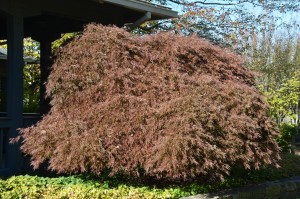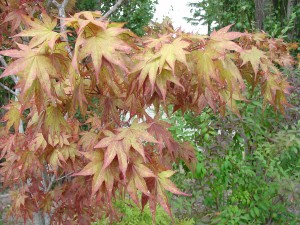Japanese maples (Acer palmatum) and (A. japonicum) are among the most picturesque of trees and shrubs. Their star-shaped leaves are comprised of 5-7-9 pointed lobes, depending on variety (cultivar). Trees exhibit layered branching, cascading form, lacy foliage (dissectum types), and stunning fall color. There are countless numbers of cultivars… those with green, yellow, purple, red, bronze, or variegated leaves. Tree/shrub sizes vary from 3 feet to 50 feet in height. Many cultivars are slow growing their first two years, particularly the dissectum types.
Select a variety based on its winter hardiness. Many Japanese maples are rated hardy in Zones 5 and 6 (-10 to -20 °F). You need to protect newly planted trees against winter sun scald, related to cold injury to tree bark on the south or west side.
Protect the trunk of a newly planted tree with special tree wrap, usually kraft paper or fabric, to prevent sunscald over the first two winters. The wrap swells as the trunk diameter expands; it should be totally removed after two winters. Maintain a 2-3 inch organic based mulch layer under the tree to keep roots moist and cool.
Other Japanese maples must cope with summer heat and humidity in Southern climes (Zones 7 and 8). Leaves may scorch and require shelter from midday sun. Planting them on the east or north side of the house is ideal. Green-leaf varieties tend to be more scorch resistant than red, purple, or variegated leaf types. Providing irrigation during the hot summer months is a practical step.
Rated among the cold hardiest cultivars for zone 5:
Dissectum class: Inaba Shidare, Tamukeyama, Crimson Queen, Red Dragon, and Viridis.
Palmatum class: Bloodgood, Emperor I, Sango Kaku, Atropurpureum, Osakazuki, Heffner’s Red, and Oshio Beni.
Additional species (other than A. palmatum): Acer japonicum (full moon maple) and A. aconitifolium (fernleaf maple).



 Posted in
Posted in 
